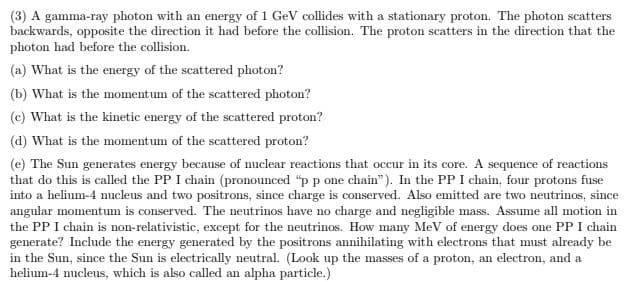(3) A gamma-ray photon with an energy of 1 GeV collides with a stationary proton. The photon scatters backwards, opposite the direction it had before the collision. The proton scatters in the direction that the photon had before the collision. (a) What is the energy of the scattered photon? (b) What is the momentum of the scattered photon? (c) What is the kinetic energy of the scattered proton? (d) What is the momentum of the scattered proton? (e) The Sun generates energy because of muclear reactions that occur in its core. A sequence of reactions that do this is called the PP I chain (pronounced "p p one chain"). In the PP I chain, four protons fuse into a helium-4 nucleus and two positrons, since charge is conserved. Also emitted are two neutrinos, since angular momentum is conserved. The neutrinos have no charge and negligible mass. Assume all motion in the PP I chain is non-relativistic, except for the neutrinos. How many MeV of energy does one PP I chain generate? Include the energy generated by the positrons annihilating with electrons that must already be in the Sun, since the Sun is electrically neutral. (Look up the masses of a proton, an electron, and a helium-4 nucleus, which is also called an alpha particle.)
(3) A gamma-ray photon with an energy of 1 GeV collides with a stationary proton. The photon scatters backwards, opposite the direction it had before the collision. The proton scatters in the direction that the photon had before the collision. (a) What is the energy of the scattered photon? (b) What is the momentum of the scattered photon? (c) What is the kinetic energy of the scattered proton? (d) What is the momentum of the scattered proton? (e) The Sun generates energy because of muclear reactions that occur in its core. A sequence of reactions that do this is called the PP I chain (pronounced "p p one chain"). In the PP I chain, four protons fuse into a helium-4 nucleus and two positrons, since charge is conserved. Also emitted are two neutrinos, since angular momentum is conserved. The neutrinos have no charge and negligible mass. Assume all motion in the PP I chain is non-relativistic, except for the neutrinos. How many MeV of energy does one PP I chain generate? Include the energy generated by the positrons annihilating with electrons that must already be in the Sun, since the Sun is electrically neutral. (Look up the masses of a proton, an electron, and a helium-4 nucleus, which is also called an alpha particle.)
Modern Physics
3rd Edition
ISBN:9781111794378
Author:Raymond A. Serway, Clement J. Moses, Curt A. Moyer
Publisher:Raymond A. Serway, Clement J. Moses, Curt A. Moyer
Chapter15: Elementary Particles
Section: Chapter Questions
Problem 4P
Related questions
Question
Parts d-e

Transcribed Image Text:(3) A gamma-ray photon with an energy of 1 GeV collides with a stationary proton. The photon scatters
backwards, opposite the direction it had before the collision. The proton scatters in the direction that the
photon had before the collision.
(a) What is the energy of the scattered photon?
(b) What is the momentum of the scattered photon?
(c) What is the kinetic energy of the scattered proton?
(d) What is the momentum of the scattered proton?
(e) The Sun generates energy because of muclear reactions that occur in its core. A sequence of reactions
that do this is called the PP I chain (pronounced "p p one chain"). In the PP I chain, four protons fuse
into a helium-4 nucleus and two positrons, since charge is conserved. Also emitted are two neutrinos, since
angular momentum is conserved. The neutrinos have no charge and negligible mass. Assume all motion in
the PP I chain is non-relativistic, except for the neutrinos. How many MeV of energy does one PP I chain
generate? Include the energy generated by the positrons annihilating with electrons that must already be
in the Sun, since the Sun is electrically neutral. (Look up the masses of a proton, an electron, and a
helium-4 nucleus, which is also called an alpha particle.)
Expert Solution
This question has been solved!
Explore an expertly crafted, step-by-step solution for a thorough understanding of key concepts.
This is a popular solution!
Trending now
This is a popular solution!
Step by step
Solved in 2 steps

Knowledge Booster
Learn more about
Need a deep-dive on the concept behind this application? Look no further. Learn more about this topic, physics and related others by exploring similar questions and additional content below.Recommended textbooks for you

Modern Physics
Physics
ISBN:
9781111794378
Author:
Raymond A. Serway, Clement J. Moses, Curt A. Moyer
Publisher:
Cengage Learning

University Physics Volume 3
Physics
ISBN:
9781938168185
Author:
William Moebs, Jeff Sanny
Publisher:
OpenStax

Modern Physics
Physics
ISBN:
9781111794378
Author:
Raymond A. Serway, Clement J. Moses, Curt A. Moyer
Publisher:
Cengage Learning

University Physics Volume 3
Physics
ISBN:
9781938168185
Author:
William Moebs, Jeff Sanny
Publisher:
OpenStax